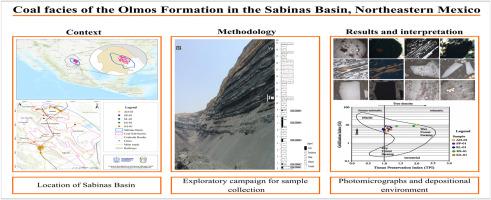Coal facies of the Olmos Formation in the Sabinas Basin, Northeastern Mexico
IF 1.5
4区 地球科学
Q3 GEOSCIENCES, MULTIDISCIPLINARY
引用次数: 0
Abstract
This work focuses on an organic petrographic study of the Olmos Formation coal sourced from five sub-basins within the Sabinas Basin (Mexico). The main goal was to determine the coal facies/depositional environment of these deposits. Organic petrographic studies revealed varying compositions across the sub-basins. The vitrinite content ranged from 73 % in the Sabinas Sub-basin to 89 % in the Adjuntas and Las Esperanzas sub-basins. The inertinite content varied from 8 % (Adjuntas Sub-basin) to 17 % (Sabinas Sub-basin). The liptinite content ranged from 2 % (Adjuntas, Las Esperanzas and San Patricio sub-basins) to 10 % (Sabinas Sub-basin). Vitrinite mean random reflectance values ranged from 0.92 % (San Patricio Sub-basin) to 1.38 % (Adjuntas Sub-basin). Gelification Index values recorded in this study varied from 4.2 (Sabinas Sub-basin) to 10.3 (Adjuntas Sub-basin), indicating relatively high wetness conditions during peat accumulation. Tissue Preservation Index values varied between 0.9 (Saltillito-Lampacitos Sub-basin) and 2.0 (Adjuntas Sub-basin), reflecting medium to well-preserved plant tissues. Groundwater Index values ranged from 0.4 (Adjuntas and Las Esperanzas sub-basins) to 1.1 (Saltillito-Lampacitos Sub-basin), suggesting a transition between ombrotrophic and rheotrophic hydrological conditions. The Vegetation Index varied between 1.0 (Saltillito-Lampacitos and San Patricio sub-basins) and 2.1 (Adjuntas Sub-basin), reflecting organic matter dominated by herbaceous vegetation. Four depositional sub-environments were identified: (i) a fen swamp sub-environment under limno-telmatic to telmatic conditions (Saltillito-Lampacitos Sub-basin), (ii) a fen swamp sub-environment under telmatic conditions (Sabinas and San Patricio sub-basins), (iii) a transitional sub-environment between fen and wet forested telmatic swamp (Las Esperanzas Sub-basin), and (iv) a wet forested telmatic swamp sub-environment (Adjuntas Sub-basin).

墨西哥东北部Sabinas盆地Olmos组煤相研究
这项工作的重点是对来自Sabinas盆地(墨西哥)五个子盆地的Olmos组煤进行有机岩石学研究。主要目的是确定这些矿床的煤相/沉积环境。有机岩相学研究表明,各次盆地的组成各不相同。镜质组含量从Sabinas次盆地的73%到Adjuntas和Las Esperanzas次盆地的89%不等。含砷量从8% (Adjuntas次盆地)到17% (Sabinas次盆地)不等。岩石含量从2% (Adjuntas、Las Esperanzas和San Patricio子盆地)到10% (Sabinas子盆地)不等。镜质组平均随机反射率从0.92% (San Patricio子盆地)到1.38% (Adjuntas子盆地)不等。本研究记录的凝胶化指数值从4.2 (Sabinas子盆地)到10.3 (Adjuntas子盆地)不等,表明泥炭积累过程中湿度相对较高。组织保存指数在0.9 (Saltillito-Lampacitos亚盆地)和2.0 (Adjuntas亚盆地)之间变化,反映了中等至较好保存的植物组织。地下水指数从0.4 (Adjuntas和Las Esperanzas子流域)到1.1 (saltillitto - lampacitos子流域)不等,表明该流域的水文条件介于营养型和流变型之间。植被指数在1.0 (Saltillito-Lampacitos和San Patricio子盆地)和2.1 (Adjuntas子盆地)之间变化,反映有机质以草本植被为主。确定了4个沉积亚环境:(i)沼泽—滨海—滨海条件下的沼泽亚环境(saltillitto - lampacitos子盆地),(ii)滨海条件下的沼泽亚环境(Sabinas和San Patricio子盆地),(iii)沼泽—湿润森林滨海沼泽过渡亚环境(Las Esperanzas子盆地),(iv)湿润森林滨海沼泽亚环境(Adjuntas子盆地)。
本文章由计算机程序翻译,如有差异,请以英文原文为准。
求助全文
约1分钟内获得全文
求助全文
来源期刊

Journal of South American Earth Sciences
地学-地球科学综合
CiteScore
3.70
自引率
22.20%
发文量
364
审稿时长
6-12 weeks
期刊介绍:
Papers must have a regional appeal and should present work of more than local significance. Research papers dealing with the regional geology of South American cratons and mobile belts, within the following research fields:
-Economic geology, metallogenesis and hydrocarbon genesis and reservoirs.
-Geophysics, geochemistry, volcanology, igneous and metamorphic petrology.
-Tectonics, neo- and seismotectonics and geodynamic modeling.
-Geomorphology, geological hazards, environmental geology, climate change in America and Antarctica, and soil research.
-Stratigraphy, sedimentology, structure and basin evolution.
-Paleontology, paleoecology, paleoclimatology and Quaternary geology.
New developments in already established regional projects and new initiatives dealing with the geology of the continent will be summarized and presented on a regular basis. Short notes, discussions, book reviews and conference and workshop reports will also be included when relevant.
 求助内容:
求助内容: 应助结果提醒方式:
应助结果提醒方式:


